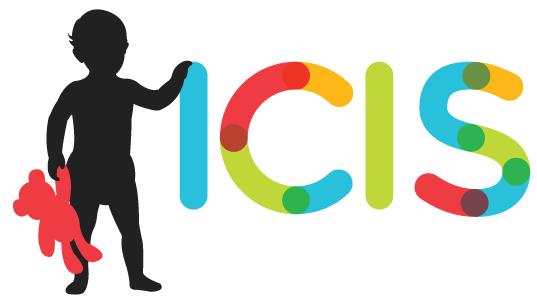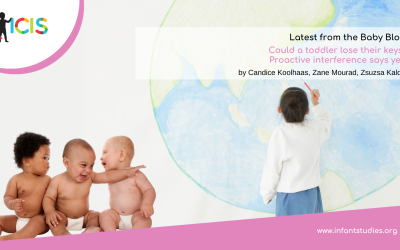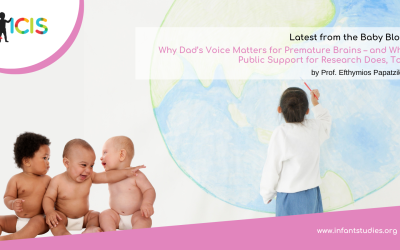by Ashley Ruba
COVID-19 completely changed our social lives. Between physical distancing, cancelled family gatherings, and continual mask-wearing, we have seen far less of one another. While these social changes have been undeniably difficult for everyone, caregivers have been especially concerned about how these changes might impact their infants. In many conversations over the past year, I have been asked the same question: how will mask-wearing impact infants’ emotional development?
How do infants learn about others’ emotions?
Infants’ environments are full of emotions. Caregivers, siblings, and others display their emotions in many different ways across many different situations. From the moment they are born, infants are bathed in this rich emotional information.
A few months after birth, infants begin to notice subtle differences in how people display emotions (Ruba & Repacholi, 2020). Four-month-olds can see the difference between a smile and a frown, and they can hear the difference between laughter and crying. Shortly thereafter, infants learn that different types of emotion cues tend to pair together. Seven-month-olds expect a smiling face to pair with laughter, and a frowning face to pair with sounds of crying. Infants also start to notice that certain emotion cues tend to occur in different types of situations. Caregivers may predictably smile and laugh during playtime, frown and raise their voice when mediating a sibling disagreement, and scrunch their noses when changing a particularly dirty diaper. Infants are remarkable learners, and even 10-month-olds have begun to determine when, how, and why people display emotions (Ruba et al., 2019).
By their first birthday, infants are able to adjust their behavior in response to other people’s emotional cues. If an adult frowns or scrunches their nose at a new toy, 12-month-olds tend to avoid the toy. However, if an adult smiles at the toy, infants tend to play! In this case, infants have learned that an adult’s smile usually indicates that new things are safe and approachable, while a frown indicates the opposite. Through a year of observing and interacting with people, infants have learned how to use other’s emotion cues to navigate their world (Ruba & Pollak, 2020a).
Learning about emotions during COVID-19
So, what about infants born in the past year? Will infants be able to learn about emotions—including expressions like smiles and frowns—if they cannot see people’s full faces?
In answering this question, we must keep a few things in mind. First, infants (especially newborns) spend much of their time at home with one to three caregivers. Infants’ early experiences with faces are limited to these few individuals (Smith et al., 2018), who are likely not wearing masks constantly inside their homes.
Second, and more importantly, emotions are not just displayed on the face. Emotions are communicated in many ways, including tone of voice, body posture, and physical touch. Infants can use all of these cues to figure out how another person is feeling, even if that person is wearing a mask. In fact, infants may be better at responding to emotions from tone of voice than from the face alone (Vaish & Striano, 2004). This is especially true for newborns, who have rather poor vision, but excellent hearing. While many people (including infant researchers) tend to focus on facial expressions of emotion, faces are not the only clue—or even the most important clue—to figuring out how another person is feeling (Barrett et al., 2019).
Finally, children can still determine how another person is feeling, even if that person is wearing a mask. In a recent study, Dr. Seth Pollak and I asked 7- to 12-year-old children to guess what emotion a person was displaying, based on a picture (Ruba & Pollak, 2020b). The pictures were people displaying stereotypical emotions while wearing masks, sunglasses, or no face covering. As you might expect, children’s emotion perception was better for uncovered faces compared to faces wearing masks and sunglasses; however, children still performed better than random guessing for all faces. Importantly, children’s emotion perception for masked faces did not differ from their emotion perception for faces with sunglasses. Since children regularly see people wearing sunglasses, with no obvious detriment to their emotional development, it is likely that mask-wearing would not dramatically impair emotional development either (for a similar study, see also Carbon, 2020). It is important to note that this study examined older children rather than young infants, and to date, no studies have assessed infants’ emotional development during this period of mask wearing. No doubt, infancy researchers will conduct these studies over the next few years.
Helping infants learn about emotions
Although infants can still learn about emotions from people wearing masks, caregivers can take additional steps to facilitate their infants’ emotional development. Most importantly, caregivers should talk about emotions with their infants, early and often. Labeling your emotions clearly communicates how you feel, which is particularly important while wearing a face mask. In addition, labeling emotions (“You’re so happy!”), asking questions about emotions (e.g., “Do you feel happy?”), and elaborating on emotions (e.g., “You feel happy because grandma is here.”) facilitates infants’ emotional development (Tompkins et al., 2018). Even if your child is too young to talk, hearing these labels helps infants learn about emotions (Ruba et al., 2020). And even if you are wearing a mask, infants can still recognize familiar spoken words (Singh et al., 2021)!
Understandably, many concerns have been raised about the impact of COVID-19 on infant development. And while it will be several years before science has carefully examined these impacts, caregivers can take comfort in current research on infant emotion learning.
If you have expertise in covid-related issues in countries outside the United States and would like to write a post for the ICIS Baby Blog, please let us know!
About the Author

Ashley Ruba
University of Wisconsin-Madison
Ashley L. Ruba is a Postdoctoral Scholar at the University of Wisconsin – Madison




